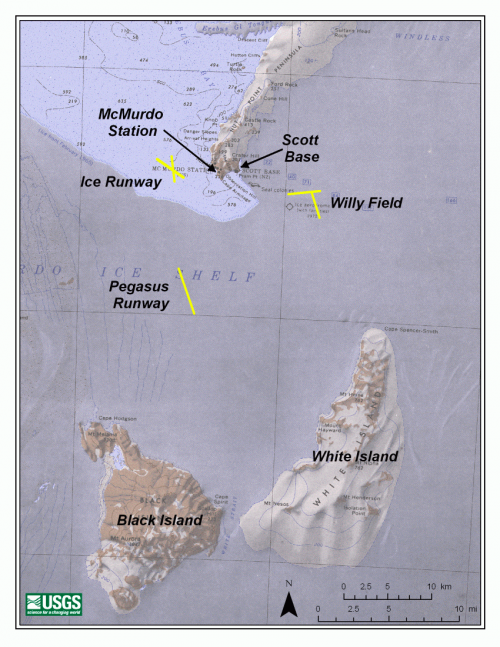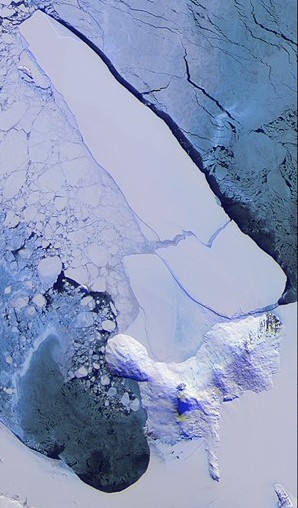In early August of this year, Chicago O'Hare broke ground on their newest East-West runway at 11,245 ft and 200 ft wide – it will the second longest at O'Hare and will continue to expand the service at one of the nation's busiest airports. It's not often that a runway gets built – runways are often refurbished, lengthened, or improved it other ways – but altogether new ones? Nope, just not that often any more. In the realm of "not that often" anything that gets done in Antarctica is "not that often" – but building a runway down here falls at the far end of that category in the "almost never" realm. This year that changes with the opening of Phoenix – a new runway to replace the aging Pegasus (where I landed) and is a one-of-a-kind piece of a Antarctic engineering.
Ice Runways: Good, Bad, and the Ugly
McMurdo Station has had multiple runways for years that were used for different purposes and at different times of the year. There used to be an ice runway in front of McMurdo that was used during the busy first part of the season from September to December before the ice eventually became too thin and the other fields had to be used. The advantage was that by using the ice runway, it saved Williams (Willy) Field and Pegasus Field from early season pounding as well as road damage out to the fields. Additionally, the ice runway went away by itself, materials and equipment could be removed and any problems would go away, the field needing to recreated every year – at a large cost of man hours, nearly 5000 each year.

Explorers of old knew that the older the sea ice was, the more likely that they could scrap off the top layers and enjoy fresh water. This is because as sea ice grows older the salt starts to leach out of it, pulled by the force of gravity over time. That means that as sea ice gets older it also becomes less flexible since the the thing that was giving it flexibility (salt molecules between the water molecules) was slowly being dragged back into the ocean. In McMurdo Sound this isn't a problem however, since normally the fast ice (remember that journal about sea ice) breaks up every year (hence one of the benefits of an ice runway, it goes away along with all of its problems). That's what normally happens ...
The Iceberg Years 2000-2005

Since the ice breaker was breaking the channel every year, new ice was forming every year. So it was a matter of reorienting the ship channel to meet the specifications of the airstrip and, presto, you have a new ice runway again every year. But it can't be that easy can it? Nothing in Antarctica is ever that easy. Turns out the new ice wasn't behaving in the way that was expected. The old ice that formed the edges of the ship channel was up to 20 ft thick and as a result created a sort of natural cooling effect on the water in the channel. Simply put, this changed the way that the sea ice was being created and the new sea ice was not getting very thick (great for ice breaker every year – not so great for the planes). Landing a C-141 aircraft needs roughly 53 inches of ice thickness to support its 323,000 pounds, but landing a C-17 (what I flew in on) requires 68 inches of ice to support its significantly more 490,000 pounds. This just wasn't going to work and the sea ice runway was abandoned.

The abandonment of the sea ice runway meant that all the transport work had to be completed by the C-130 Hercules aircraft – which can carry less cargo and personnel. The airlift became less efficient and therefore more costly. Something needed to be done.
Pegasus
Pegasus was constructed on the McMurdo Ice Shelf from 1988-89 after a search of possible locations. Placing it on the ice shelf meant that, like Williams Field, it could be used year to year and not be reconstructed every year like the old sea ice runway. The site met the criteria that had been specified: the ice needed to be close to support McMurdo, and have enough snow to be covered during the summer but not so much that it made landing the C-17 wheeled aircraft problematical. This came with its own problems of course, not the least of which was how do you create a flat surface? The sea ice was already flat, but ice shelves are not flat despite their appearances. The chosen site had its share of bumps and valleys that needed to be dealt with. You can't just bring a Zamboni down to McMurdo and start driving it around (yes it was considered) – that won't as it turns out work. A new blade design was developed especially for this purpose and the world's largest and most specialized ice shaver got to work. Soon the new field was graded and ready to accept aircraft. Done right? Well not quite ... remember nothing in Antarctica is ever that easy. But you'll have to wait ... tomorrow the story continues ...



Comments